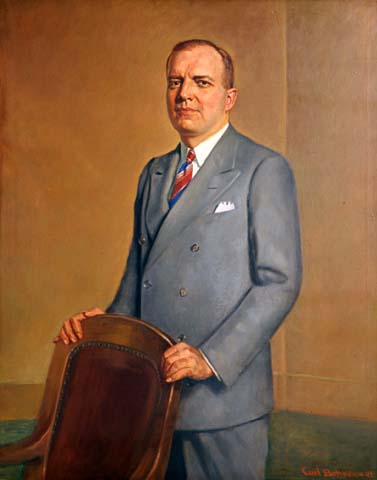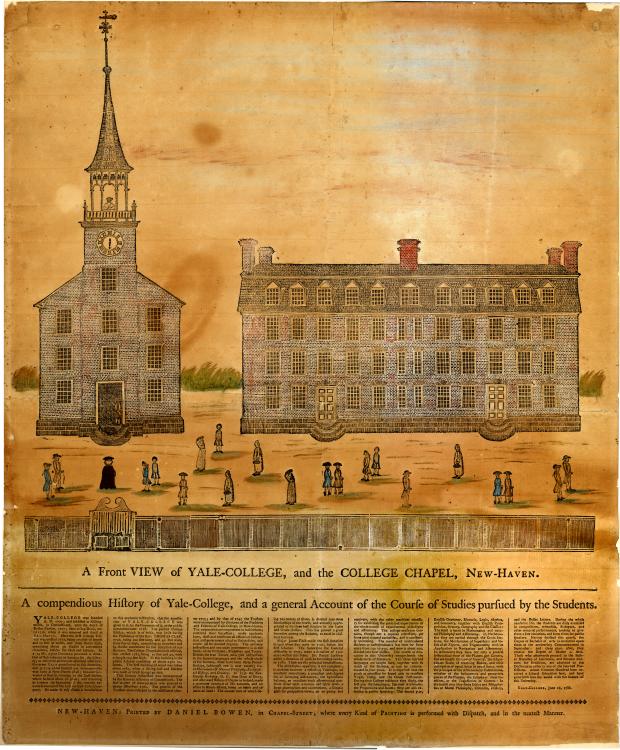|
Academic Procession
An academic procession is a traditional ceremony in which university dignitaries march together wearing traditional academic dress. An academic procession forms a usual part of college and university graduation exercises. At many U.S. universities, the colors and styles of regalia are determined by a uniform dress code established in 1895. The installation of a university president is usually accompanied by a much more elaborate academic procession, involving visiting celebrants from other universities. In such processions, the order of appearance is governed by the institution's date of founding, oldest first. For example, when Eisenhower was installed at Columbia in 1948: ...dignitaries from the world's oldest universities—Bologna, Oxford, Paris, Cambridge, and Florence—led the procession, and representatives from over three hundred American colleges and universities followed, including Harvard's James Conant, Yale's Charles Seymour, Pennsylvania's Harold Stass ... [...More Info...] [...Related Items...] OR: [Wikipedia] [Google] [Baidu] [Amazon] |
James Bryant Conant
James Bryant Conant (March 26, 1893 – February 11, 1978) was an American chemist, a transformative President of Harvard University, and the first U.S. Ambassador to West Germany. Conant obtained a Ph.D. in chemistry from Harvard in 1916. During World War I, he served in the U.S. Army, where he worked on the development of poison gases, especially lewisite. He became an assistant professor of chemistry at Harvard University in 1919 and the Sheldon Emery Professor of Organic Chemistry in 1929. He researched the physical structures of natural products, particularly chlorophyll, and he was one of the first to explore the sometimes complex relationship between chemical equilibrium and the reaction rate of chemical processes. He studied the biochemistry of oxyhemoglobin providing insight into the disease methemoglobinemia, helped to explain the structure of chlorophyll, and contributed important insights that underlie modern theories of acid-base chemistry. In 1933, Cona ... [...More Info...] [...Related Items...] OR: [Wikipedia] [Google] [Baidu] [Amazon] |
Encaenia
Encaenia ( ) is an academic or sometimes ecclesiastical ceremony, usually performed at colleges or universities. It generally occurs some time near the annual ceremony for the general conferral of degrees to students. The word is from Latin, meaning dedication or consecration, and is ultimately derived from the Ancient Greek ἐγκαίνια (''enkainia''), meaning a festival of renewal or dedication, and corresponds to the English language, English term ''commencement''. The term was originally used to indicate the eight days of celebration for the dedication of the Church of the Holy Sepulchre in Jerusalem, which celebration covered also to the discovering of the True Cross by Empress Helena of Constantinople, Helena in 326. Because the Church of the Holy Sepulchre was consecrated on September 13, 335, the Encaenia started on September 13, while the cross itself was brought outside the church on September 14 so that the clergy and faithful could pray before the True Cross (Feas ... [...More Info...] [...Related Items...] OR: [Wikipedia] [Google] [Baidu] [Amazon] |
Academic Administration
Academic administration is a branch of university or college employees responsible for the maintenance and supervision of the institution and separate from the faculty or academics, although some personnel may have joint responsibilities. Some type of separate administrative structure exists at almost all academic institutions. Fewer institutions are governed by employees who are also involved in academic or scholarly work. Many senior administrators are academics who have advanced degrees and no longer teach or conduct research. Key responsibilities Key broad administrative responsibilities (and thus administrative units) in academic institutions include: * Admissions * Supervision of academic affairs such as hiring, promotion, tenure, and evaluation (with faculty input where appropriate); * Maintenance of official records (typically supervised by a registrar); * Maintenance and audit of financial flows and records; * Maintenance and construction of campus buildings and gro ... [...More Info...] [...Related Items...] OR: [Wikipedia] [Google] [Baidu] [Amazon] |
Charity School
Charity schools, sometimes called blue coat schools, or simply the Blue School, were significant in the history of education in England. They were built and maintained in various parishes by the voluntary contributions of the inhabitants to teach poor children to read and write, and for other necessary parts of education. They were usually maintained by religious organisations, which provided clothing and education to students freely or at little charge. In most charity schools, children were put out to trades, services, etc., by the same charitable foundation. Some schools were more ambitious than this and sent a few pupils on to university. Charity schools began in London, and spread throughout most of the urban areas in England and Wales. By 1710, the statistics for charity schools in and around London were as follows: number of schools, 88; boys taught, 2,181; girls, 1,221; boys put out to apprentices, 967; girls, 407. By the 19th century, English elementary schools were ... [...More Info...] [...Related Items...] OR: [Wikipedia] [Google] [Baidu] [Amazon] |
Princeton University
Princeton University is a private university, private Ivy League research university in Princeton, New Jersey, United States. Founded in 1746 in Elizabeth, New Jersey, Elizabeth as the College of New Jersey, Princeton is the List of Colonial Colleges, fourth-oldest institution of higher education in the United States and one of the nine colonial colleges chartered before the American Revolution. The institution moved to Newark, New Jersey, Newark in 1747 and then to its Mercer County, New Jersey, Mercer County campus in Princeton nine years later. It officially became a university in 1896 and was subsequently renamed Princeton University. The university is governed by the Trustees of Princeton University and has an endowment of $37.7 billion, the largest List of colleges and universities in the United States by endowment, endowment per student in the United States. Princeton provides undergraduate education, undergraduate and graduate education, graduate instruction in the hu ... [...More Info...] [...Related Items...] OR: [Wikipedia] [Google] [Baidu] [Amazon] |
Harold Stassen
Harold Edward Stassen (April 13, 1907 – March 4, 2001) was an American Republican Party (United States), Republican Party politician, military officer, and attorney who was the List of governors of Minnesota, 25th governor of Minnesota from 1939 to 1943. He was a leading candidate for the 1948 Republican Party presidential primaries, Republican nomination for president of the United States in 1948. Though he was considered for a time to be the front-runner, he lost the nomination to New York (state), New York governor Thomas E. Dewey. He thereafter regularly continued to run for the presidency and other offices, such that his name became most identified with his status as a perennial candidate. Born in West St. Paul, Minnesota, Stassen was elected as the county attorney of Dakota County, Minnesota after graduating from the University of Minnesota. He won election as Governor of Minnesota in 1938. Stassen is the youngest person elected to that office. He gave the keynote address ... [...More Info...] [...Related Items...] OR: [Wikipedia] [Google] [Baidu] [Amazon] |
University Of Pennsylvania
The University of Pennsylvania (Penn or UPenn) is a Private university, private Ivy League research university in Philadelphia, Pennsylvania, United States. One of nine colonial colleges, it was chartered in 1755 through the efforts of founder and first president Benjamin Franklin, who had advocated for an educational institution that trained leaders in academia, commerce, and public service. The university has four undergraduate schools and 12 graduate and professional schools. Schools enrolling undergraduates include the College of Arts and Sciences, the University of Pennsylvania School of Engineering and Applied Science, School of Engineering and Applied Science, the Wharton School, and the University of Pennsylvania School of Nursing, School of Nursing. Among its graduate schools are its University of Pennsylvania Law School, law school, whose first professor, James Wilson (Founding Father), James Wilson, helped write the Constitution of the United States, U.S. Cons ... [...More Info...] [...Related Items...] OR: [Wikipedia] [Google] [Baidu] [Amazon] |
Charles Seymour
Charles Seymour (January 1, 1885 – August 11, 1963) was an American academic, historian and the 15th President of Yale University from 1937 to 1951. As an academic administrator, he was instrumental in establishing Yale's residential college system. His writing focused on the diplomatic history of World War I. Early life and education Seymour was born in New Haven, Connecticut, the son of Thomas Day Seymour, who taught classics at Yale, and Sarah Hitchcock Seymour. His paternal grandfather, Nathan Perkins Seymour, was the great-great grandson of Thomas Clap, who was President of Yale in the 1740s. His paternal grandmother, Elizabeth Day, was the grandniece of Jeremiah Day, who was Yale's president from 1817 through 1846. An ancestor of his mother, the former Sarah Hitchcock, was awarded an honorary degree at Yale's first graduation ceremonies in 1702. [...More Info...] [...Related Items...] OR: [Wikipedia] [Google] [Baidu] [Amazon] |
Yale University
Yale University is a Private university, private Ivy League research university in New Haven, Connecticut, United States. Founded in 1701, Yale is the List of Colonial Colleges, third-oldest institution of higher education in the United States, and one of the nine colonial colleges chartered before the American Revolution. Yale was established as the Collegiate School in 1701 by Congregationalism in the United States, Congregationalist clergy of the Connecticut Colony. Originally restricted to instructing ministers in theology and sacred languages, the school's curriculum expanded, incorporating humanities and sciences by the time of the American Revolution. In the 19th century, the college expanded into graduate and professional instruction, awarding the first Doctor of Philosophy, PhD in the United States in 1861 and organizing as a university in 1887. Yale's faculty and student populations grew rapidly after 1890 due to the expansion of the physical campus and its scientif ... [...More Info...] [...Related Items...] OR: [Wikipedia] [Google] [Baidu] [Amazon] |
Harvard University
Harvard University is a Private university, private Ivy League research university in Cambridge, Massachusetts, United States. Founded in 1636 and named for its first benefactor, the History of the Puritans in North America, Puritan clergyman John Harvard (clergyman), John Harvard, it is the oldest institution of higher learning in the United States. Its influence, wealth, and rankings have made it one of the most prestigious universities in the world. Harvard was founded and authorized by the Massachusetts General Court, the governing legislature of Colonial history of the United States, colonial-era Massachusetts Bay Colony. While never formally affiliated with any Religious denomination, denomination, Harvard trained Congregationalism in the United States, Congregational clergy until its curriculum and student body were gradually secularized in the 18th century. By the 19th century, Harvard emerged as the most prominent academic and cultural institution among the Boston B ... [...More Info...] [...Related Items...] OR: [Wikipedia] [Google] [Baidu] [Amazon] |
Academic Dress
Academic dress is a traditional form of clothing for academia, academic settings, mainly tertiary education, tertiary (and sometimes secondary schools, secondary) education, worn mainly by those who have obtained a university degree (or similar), or hold a status that entitles them to assume them (e.g., undergraduate students at certain old universities). It is also known as academical dress, academicals, or academic regalia. Contemporarily, it is commonly seen only at graduation ceremonies, but formerly academic dress was, and to a lesser degree in many ancient universities still is, worn daily. Today, the ensembles are distinctive in some way to each institution, and generally consist of a gown (also known as a robe) with a separate hood (headgear), hood, and usually a cap (generally either a square academic cap, a tam (cap), tam, or a Tudor bonnet, bonnet). Academic dress is also worn by members of certain learned societies and institutions as official dress. Overview and h ... [...More Info...] [...Related Items...] OR: [Wikipedia] [Google] [Baidu] [Amazon] |







